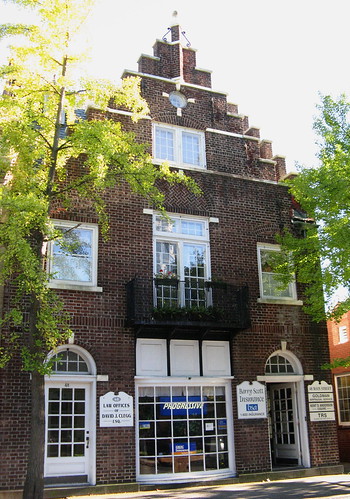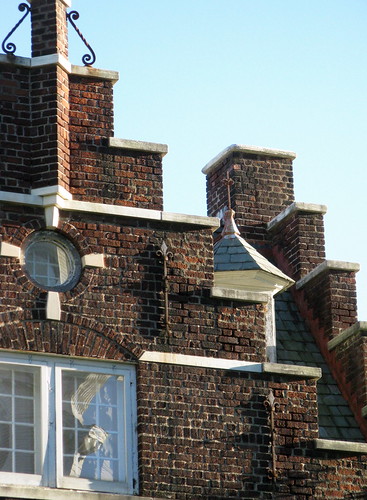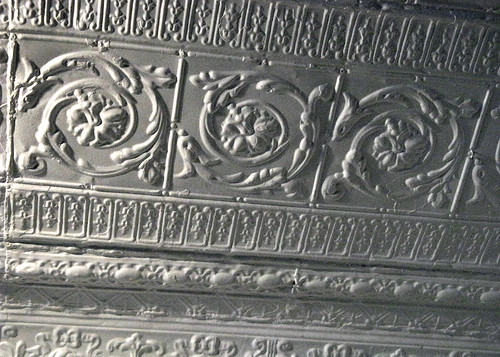Call it Old Europe and the Dutch colonies meet the early 20th century. The Wiltwyck Inn is a petite building, by no means grand. This two-and-a-half story structure, tucked among plenty of historic buildings in the Uptown Stockade neighborhood of Kingston, conjures up faraway places and times long ago, thanks to its personality and out-of-the-ordinary, even inviting, shape.
During the many times I’ve walked by this building I’ve marveled at its warm, quirky looks and wondered where it came from. The Wiltwyck Inn looks the way it does because of the vision of one architect who sought, when he designed it, to connect the structure to the Hudson Valley’s Dutch ancestral roots. Completed around 1910, it opened as an inn, and its early years were steeped in both the graciousness of home and the adventure of the road, catering to women as a gathering place and those out “motoring” and touring in the early days of the automobile. Today, its identity as a commercial building is more pedestrian, since it includes law offices and an insurance agency, but the Wiltwyck Inn’s sweet design and history easily allows one to picture those days and its beginnings.
Located at 48 Main St., this building is a piece of Holland in Kingston, especially its distinctive features, design, and welcoming appearance. Befitting the Dutch style of architecture, it has a steep roof, rough and variegated brickwork, and stepped gables, which are the “stair steps” atop the gable ends. With its many gabled angles, it feels right out of Old Europe.
The Wiltwyck Inn building, on Kingston’s Main Street
The Wiltwyck Inn building’s many angles
Its pleasing design is set off by delicate features that help give the Wiltwyck its “inn” feeling. They range from a portal window near the top and a curved second-floor balcony to dormer windows and wrought-iron embellishments. I find myself looking often at the inn’s adornments and different angles, as much for the images they generate of being transported to another time or place as for their intrinsic interest. Similar-looking buildings abound in the Netherlands, from a building along the canal Galgewater in Leiden to row houses in Haarlem.
Ancestry and Architecture
Whoever named the Wiltwyck Inn decided to name it after the 17th century Dutch village that later evolved into Kingston – the third major settlement of the Dutch in New Netherland after New Amsterdam (New York) and Fort Orange (Albany). But architect Myron Teller’s design most makes this place Dutch. As author William B. Rhoads explains in his book, Kingston, New York: The Architectural Guide, Teller chose to create a “stately Dutch inn” that would be associated with 17th century Dutch architecture and suit its location facing the Old Dutch Church and its historic burial ground.
Teller’s choice of a Dutch style wasn’t surprising. One of the most prominent architects of the Hudson Valley in the early 20th century, Teller had a “lifelong love of colonial Dutch architecture,” according to the newsletter of the Society for the Preservation of Hudson Valley Architecture (June-July 2007), though he designed highly regarded buildings in other styles as well. He possessed pride in his Hudson Valley Dutch ancestry, Rhoads writes.
Anyone who appreciates centuries-old stone houses owes a debt to this architect, who was a Kingston native. Among his many major accomplishments and commissions in Kingston and Ulster County, Teller restored various stone houses from the Dutch colonial era. He also developed a business of hand-wrought hardware in colonial patterns, at a blacksmith shop he established in Kingston. As Rhoads explains in his book, Teller’s skill in restoring colonial stone houses became so admired that the author and historian whose work was associated with such houses, Helen Reynolds, recommended that Teller be welcomed as a member of the Holland Society. Such a designation linked Teller by blood to the Hudson Valley’s Dutch colonists.
Bridging the Colonial and the Modern
But if the Wiltwyck Inn recalled the 17th century days of Dutch settlers, it embraced the new norms and finer things of the 20th century. The inn’s proprietor and Teller’s client, Mary Kenney, sought to “provide women with intimate and refined places for tea and luncheons,” part of a movement in the early 20th century, Rhoads writes in his Kingston guide. It also made a pitch for the newly touring crowds seeking the freedom of the road in their cars. A display advertisement on page 239 of the 1921 Automobile Blue Book – the “standard road guide of America” – shows a full photo of the Wiltwyck Inn, touting its “New Colonial Building” and “Dining and Tea Room.” The ad advertises that the inn is “Noted for home cooking and quick service. Assorted Chocolates and Bon-Bons. Salted Nuts. Open Sundays. All Conveniences.”
Bonbons, salted nuts…just the mention creates the sense of a cozy place, a relaxing time, the small things that weren’t luxuries but still meant a lot. In fact, it jogs a childhood memory of my mother in the early 1960s, gathering with the other ladies in her card club. They would set out small china and glass bowls of nuts and mints on the card tables. Perhaps that’s what the sight of the Wiltwyck Inn’s quirky, old-fashioned, and stepped-gabled old building conveys – times gone by that live in sweet thoughts and memories.
The building also brings up images of those odd-angled commercial buildings in the Western Pennsylvania towns near where I grew up, the structures along a railroad or business street. Often, the shape, personality, and aura of buildings resonate with our own experience. Our mind’s eye will even see the places in our past.
In designing an unpretentious Dutch-style inn, Myron Teller linked the Wiltwyck Inn to the Hudson Valley’s roots. In reaching across the ages, Teller was definitely onto something. We also come to love buildings for how they connect, quite spontaneously, with our own roots.
More Views
A close-up of the stepped gables
Beautiful detailing in the front room’s ceiling
Front and side view of the gables
Further Exploration
The former Wiltwyck Inn, as a part of Kingston’s Stockade Historic District, is included in the National Register of Historic Places and the New York State Register of Historic Places. Mindfulwalker.com plans to focus periodically in future posts on additional places and buildings in Kingston, which contains a rich treasure of architectural landmarks and structures.
To find out more, also check out:
The Society for the Preservation of Hudson Valley Vernacular Architecture
Kingston, New York: The Architectural Guide
Visit the slide show larger in Flickr.








What a beautiful building. It really does look like something straight out of Amsterdam. It’s fun to imagine those ladies having refined tea and luncheons long ago.
It’s amazing to see how much you’ve done with your blog, Susan. You should advertise it on the NuNomad Tribe. It would be great for anyone nomading NYC. There’s no cost to join or to advertise. There’s a category for blogs. I miss talking to you! We should chat sometime.
Carmen,
Thank you! Yes, the building is beautiful, isn’t it? Glad you think so, too. I’ve eyeballed it on my walks for quite a while.
I have not been to Amsterdam yet but now I have even more desire to go to the Netherlands. Among other methods I used, I confirmed the presence of so many of this style of building there through my photo research. As I did I could envision a very nice walk in Amsterdam or Delft.
Likewise, I see how much you and Ricardo have done with NuNomad. I believe it’s wonderful that so many are freeing themselves of Cubicleville to travel and live elsewhere while they work. Looks like you have done so much with bringing in a social networking component to create the NuNomad Tribe.
I’ll follow up later today at NuNomad and with a note to you. Thanks for stopping by Mindful Walker on your travels, and enjoy!
Susan
This beautiful building was one time the location of Helen Davenport, a women’s clothing boutique. The entrance was on the 1st floor. It was decorated with beautiful antiques, and as you sat on one of the couches, the fashions were shown to you. NO RACKS! There were 2 dressing rooms and another room for the fashions.
Helen was a dear friend of mine and I learned my love of fashion and retailing from her. She used to take me to the New York buying houses. If you bought an item from her your item would not be sold to a customer living in the area! My mom Betsy Connelly was a customer of hers since the 50’s, when she was first located in The Governor Clinton Hotel and then she moved to 48 Main. I was her youngest customer (started as a teenager).
My wedding dress was from Helen Davenport’s as were most of my clothes. How I miss those days and the beautiful fashions that Helen and other stores like Leventhal’s featured.
Barbara,
What a picture you draw of that time, of the women’s clothing boutique in the building, and of the special memories and images that you have of it all. I can envision how lovely and graceful Helen Davenport’s must have been and understand why you would miss those days and the beautiful fashions. And “fashion” is the word for it, isn’t it…just the right thing for the right season, sold in a gracious atmosphere.
It’s even more special that your wedding dress was from this boutique.
Your memories made me recall some of the small ladies’ clothing stories that were in Beaver Falls, Ellwood City, and New Castle, near where I grew up, in Western Pennsylvania.
I’m kind of awestruck that Helen Davenport’s had no racks and had sofas on which its customers sat as those working in the store showed clothing to them. Wow. This is a kind of class that the stores in today’s malls will never match.
I can see how a boutique would fit perfectly on the first floor of this beautiful building, too. I’m so happy that you’ve filled in some of the blanks over the years for the Wiltwyck Inn building, and I hope to hear and find out more.
Thanks so much!
Susan
Great work! Darn, I’ve walked past that building so many times… your pictures surely bring out a treasure.
I’d call your reporting “assisting seeing: helping you to see the beauty you might be missing.” Yep, I was missing it.
Great photos!
Hi, Gerald,
Thanks very much. Happy that this article brought out the beauty of a building you pass many times. Hey, it happens to all of us!
I like your term “assisting seeing,” and I may cite it sometime, with proper credit, of course.
Glad you enjoy the photos, too! It’s just a sweet building that calls out to capture its many angles and presence.
Happy exploring.
Susan